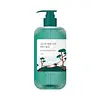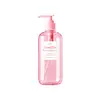What's inside
What's inside
 Key Ingredients
Key Ingredients

 Benefits
Benefits

 Concerns
Concerns

 Ingredients Side-by-side
Ingredients Side-by-side

Water
Skin ConditioningSodium C14-16 Olefin Sulfonate
CleansingPinus Densiflora Leaf Extract
AntimicrobialLauryl Betaine
CleansingSodium Chloride
MaskingAllantoin
Skin ConditioningBetaine
HumectantPanthenol
Skin ConditioningSalicylic Acid
MaskingSodium Hyaluronate
HumectantHydrolyzed Hyaluronic Acid
HumectantSodium Acetylated Hyaluronate
HumectantButylene Glycol
HumectantCentella Asiatica Extract
CleansingMelia Azadirachta Flower Extract
Skin ConditioningMelia Azadirachta Leaf Extract
Skin ConditioningGlycoproteins
Skin ConditioningSorbitol
HumectantCitric Acid
BufferingGluconolactone
Skin ConditioningAsiaticoside
AntioxidantAsiatic Acid
Skin ConditioningMadecassic Acid
Skin ConditioningMadecassoside
AntioxidantCaprylyl Glycol
EmollientCitrus Limon Fruit Extract
MaskingCitrus Nobilis Oil
MaskingLavandula Angustifolia Oil
MaskingEucalyptus Globulus Leaf Oil
PerfumingJuniperus Mexicana Oil
MaskingPinus Palustris Oil
MaskingC12-14 Pareth-12
EmulsifyingHexadecene
SolventTetradecene
EmollientTromethamine
Buffering1,2-Hexanediol
Skin ConditioningDisodium EDTA
Limonene
PerfumingWater, Sodium C14-16 Olefin Sulfonate, Pinus Densiflora Leaf Extract, Lauryl Betaine, Sodium Chloride, Allantoin, Betaine, Panthenol, Salicylic Acid, Sodium Hyaluronate, Hydrolyzed Hyaluronic Acid, Sodium Acetylated Hyaluronate, Butylene Glycol, Centella Asiatica Extract, Melia Azadirachta Flower Extract, Melia Azadirachta Leaf Extract, Glycoproteins, Sorbitol, Citric Acid, Gluconolactone, Asiaticoside, Asiatic Acid, Madecassic Acid, Madecassoside, Caprylyl Glycol, Citrus Limon Fruit Extract, Citrus Nobilis Oil, Lavandula Angustifolia Oil, Eucalyptus Globulus Leaf Oil, Juniperus Mexicana Oil, Pinus Palustris Oil, C12-14 Pareth-12, Hexadecene, Tetradecene, Tromethamine, 1,2-Hexanediol, Disodium EDTA, Limonene
Water
Skin ConditioningSodium C14-16 Olefin Sulfonate
CleansingLauramidopropyl Betaine
CleansingGlycerin
HumectantC12-14 Pareth-12
EmulsifyingParfum
MaskingSodium Chloride
MaskingCamellia Seed Oil
Helianthus Annuus Seed Oil
EmollientSimmondsia Chinensis Seed Oil
EmollientPropylene Glycol Laurate
Skin ConditioningGuar Hydroxypropyltrimonium Chloride
Skin ConditioningEthylhexylglycerin
Skin ConditioningCitric Acid
BufferingPolyquaternium-10
Hexylene Glycol
EmulsifyingAllantoin
Skin ConditioningLevulinic Acid
PerfumingPanthenol
Skin ConditioningSodium Bicarbonate
AbrasiveCaprylyl Glycol
EmollientLaurylpyridinium Chloride
AntimicrobialDisodium EDTA
Hexyl Cinnamal
PerfumingButylphenyl Methylpropional
PerfumingHydroxycitronellal
PerfumingWater, Sodium C14-16 Olefin Sulfonate, Lauramidopropyl Betaine, Glycerin, C12-14 Pareth-12, Parfum, Sodium Chloride, Camellia Seed Oil, Helianthus Annuus Seed Oil, Simmondsia Chinensis Seed Oil, Propylene Glycol Laurate, Guar Hydroxypropyltrimonium Chloride, Ethylhexylglycerin, Citric Acid, Polyquaternium-10, Hexylene Glycol, Allantoin, Levulinic Acid, Panthenol, Sodium Bicarbonate, Caprylyl Glycol, Laurylpyridinium Chloride, Disodium EDTA, Hexyl Cinnamal, Butylphenyl Methylpropional, Hydroxycitronellal
 Reviews
Reviews

Ingredients Explained
These ingredients are found in both products.
Ingredients higher up in an ingredient list are typically present in a larger amount.
Allantoin is a soothing ingredient known for its protective and moisturizingg properties. Because of this, it is often added to products with strong active ingredients.
Studies show higher concentrations of this ingredient can promote wound healing.
Though it can be derived from the comfrey plant, allantoin is produced synthetically for cosmetic products to ensure purity.
Learn more about AllantoinC12-14 Pareth-12 is created from a mixture of synthetic C12-14 alcohols that have about 12 moles of ethylene oxide.
It is an emulsifying and cleansing ingredient. Emulsifier help prevent ingredients from separating, such as oils and waters.
Caprylyl Glycol is a humectant and emollient, meaning it attracts and preserves moisture.
It is a common ingredient in many products, especially those designed to hydrate skin. The primary benefits are retaining moisture, skin softening, and promoting a healthy skin barrier.
Though Caprylyl Glycol is an alcohol derived from fatty acids, it is not the kind that can dry out skin.
This ingredient is also used as a preservative to extend the life of products. It has slight antimicrobial properties.
Learn more about Caprylyl GlycolCitric Acid is an alpha hydroxy acid (AHA) naturally found in citrus fruits like oranges, lemons, and limes.
Like other AHAs, citric acid can exfoliate skin by breaking down the bonds that hold dead skin cells together. This helps reveal smoother and brighter skin underneath.
However, this exfoliating effect only happens at high concentrations (20%) which can be hard to find in cosmetic products.
Due to this, citric acid is usually included in small amounts as a pH adjuster. This helps keep products slightly more acidic and compatible with skin's natural pH.
In skincare formulas, citric acid can:
While it can provide some skin benefits, research shows lactic acid and glycolic acid are generally more effective and less irritating exfoliants.
Most citric acid used in skincare today is made by fermenting sugars (usually from molasses). This synthetic version is identical to the natural citrus form but easier to stabilize and use in formulations.
Read more about some other popular AHA's here:
Learn more about Citric AcidDisodium EDTA plays a role in making products more stable by aiding other preservatives.
It is a chelating agent, meaning it neutralizes metal ions that may be found in a product.
Disodium EDTA is a salt of edetic acid and is found to be safe in cosmetic ingredients.
Learn more about Disodium EDTAPanthenol is a common ingredient that helps hydrate and soothe the skin. It is found naturally in our skin and hair.
There are two forms of panthenol: D and L.
D-panthenol is also known as dexpanthenol. Most cosmetics use dexpanthenol or a mixture of D and L-panthenol.
Panthenol is famous due to its ability to go deeper into the skin's layers. Using this ingredient has numerous pros (and no cons):
Like hyaluronic acid, panthenol is a humectant. Humectants are able to bind and hold large amounts of water to keep skin hydrated.
This ingredient works well for wound healing. It works by increasing tissue in the wound and helps close open wounds.
Once oxidized, panthenol converts to pantothenic acid. Panthothenic acid is found in all living cells.
This ingredient is also referred to as pro-vitamin B5.
Learn more about PanthenolSodium C14-16 Olefin Sulfonate is a cleansing agent made from a mixture of long chain sulfonate salts. It can also help produce foam.
This ingredient may be drying. We recommend speaking with a professional if you have concerns.
Chances are, you eat sodium chloride every day. Sodium Chloride is also known as table salt.
This ingredient has many purposes in skincare: thickener, emulsifier, and exfoliator.
You'll most likely find this ingredient in cleansers where it is used to create a gel-like texture. As an emulsifier, it also prevents ingredients from separating.
There is much debate on whether this ingredient is comedogenic. The short answer - comedogenic ratings don't tell the whole story. Learn more about comegodenic ratings here.
The concensus about this ingredient causing acne seems to be divided. Research is needed to understand if this ingredient does cause acne.
Scrubs may use salt as the primary exfoliating ingredient.
Learn more about Sodium ChlorideWater. It's the most common cosmetic ingredient of all. You'll usually see it at the top of ingredient lists, meaning that it makes up the largest part of the product.
So why is it so popular? Water most often acts as a solvent - this means that it helps dissolve other ingredients into the formulation.
You'll also recognize water as that liquid we all need to stay alive. If you see this, drink a glass of water. Stay hydrated!
Learn more about Water